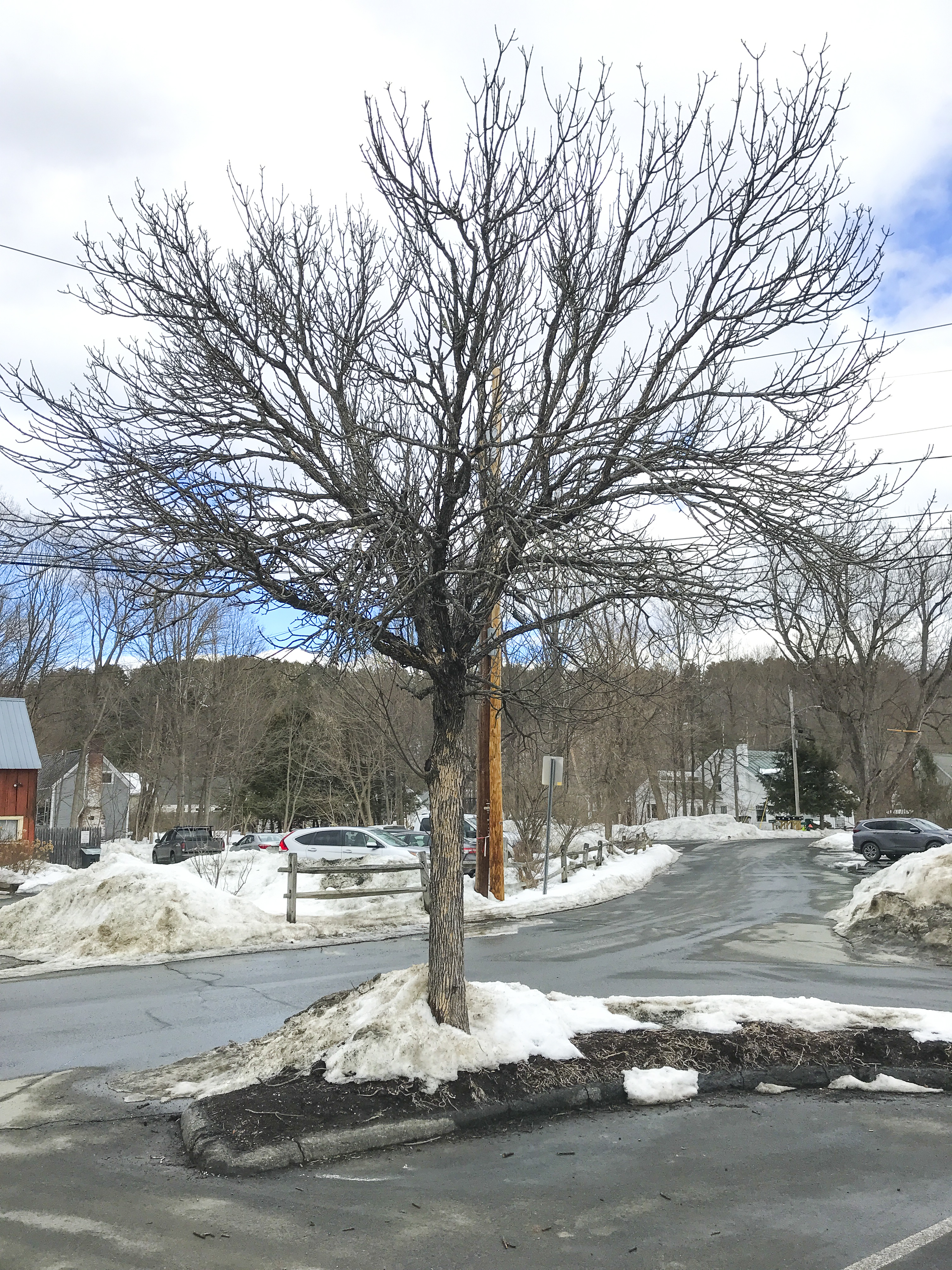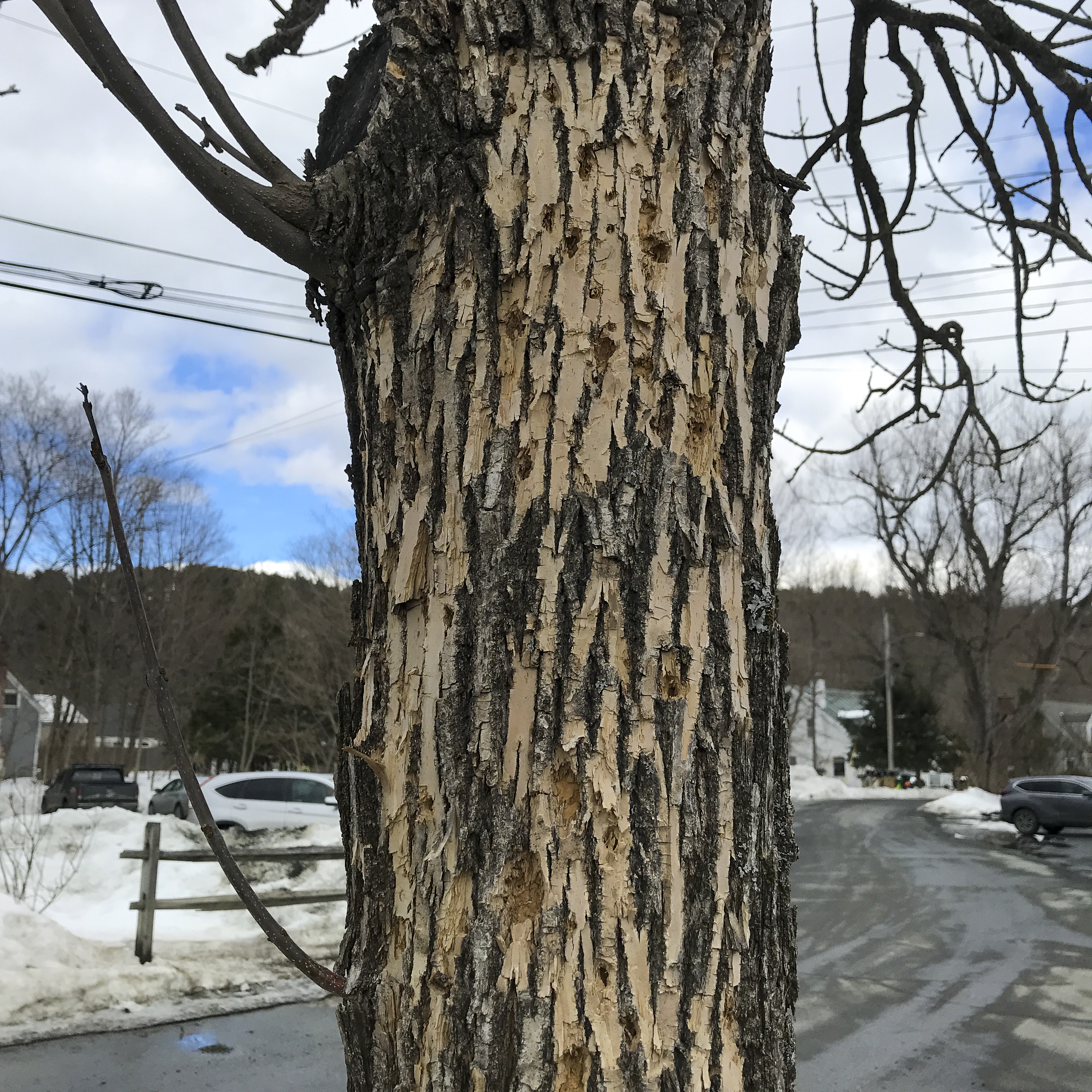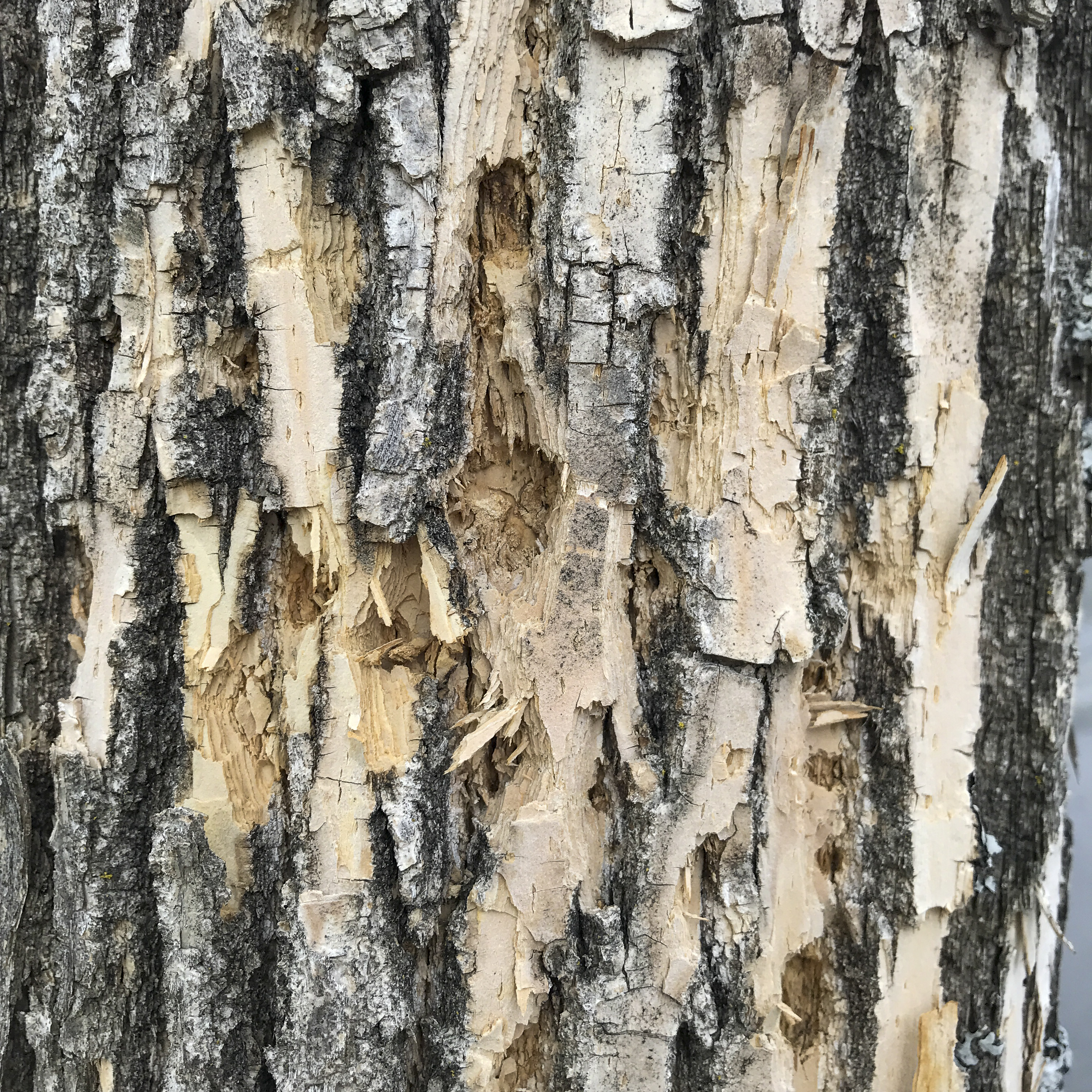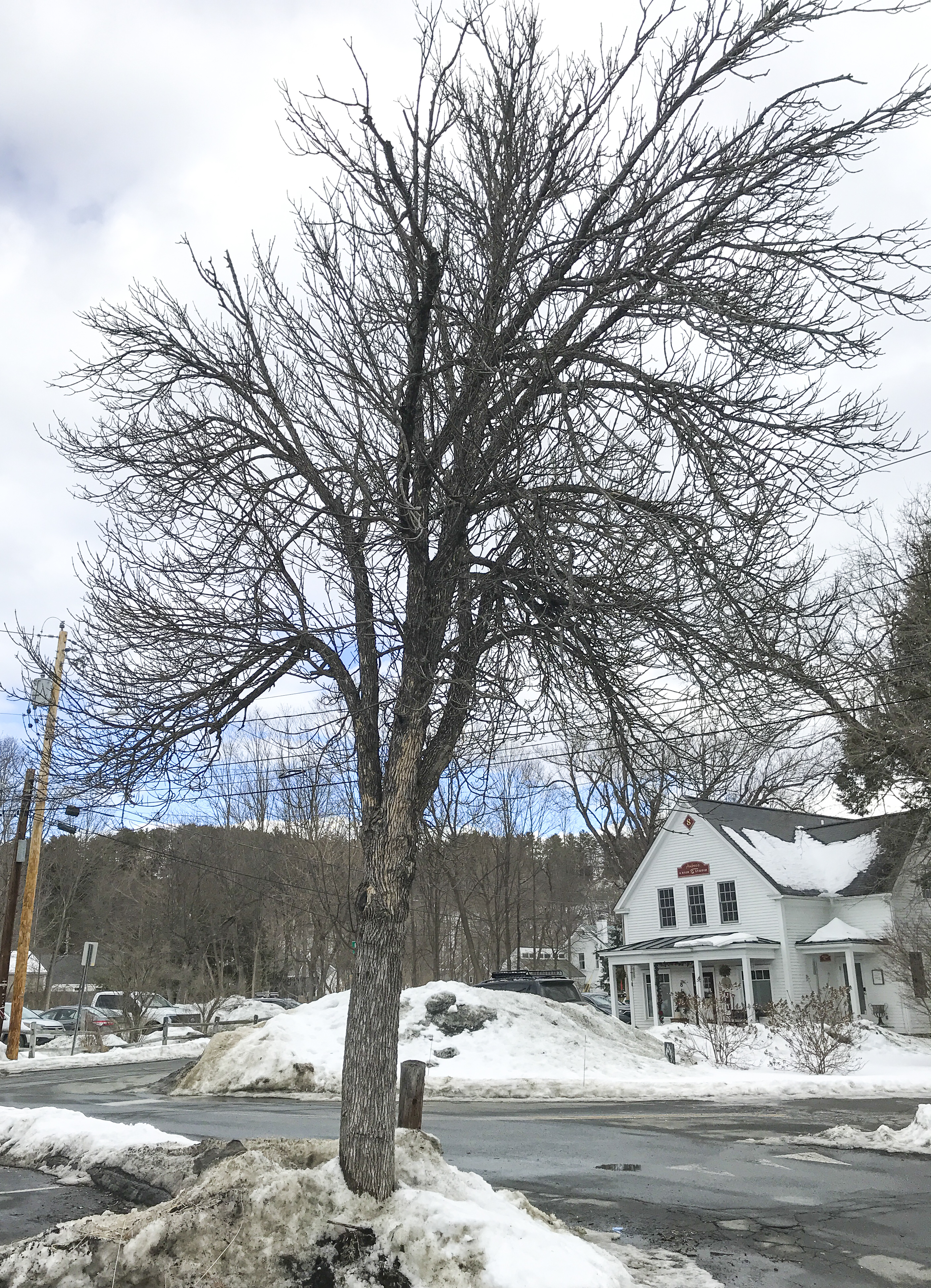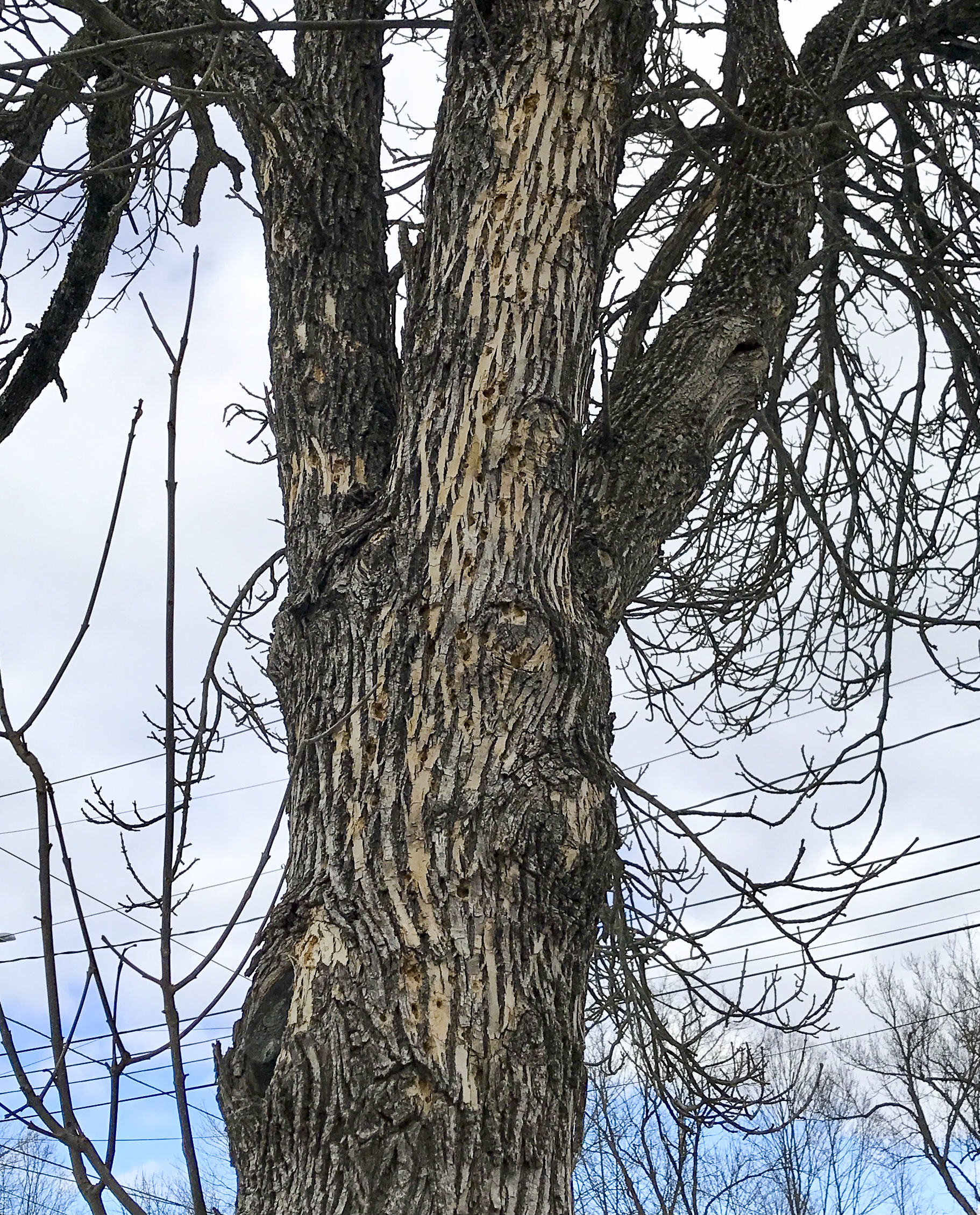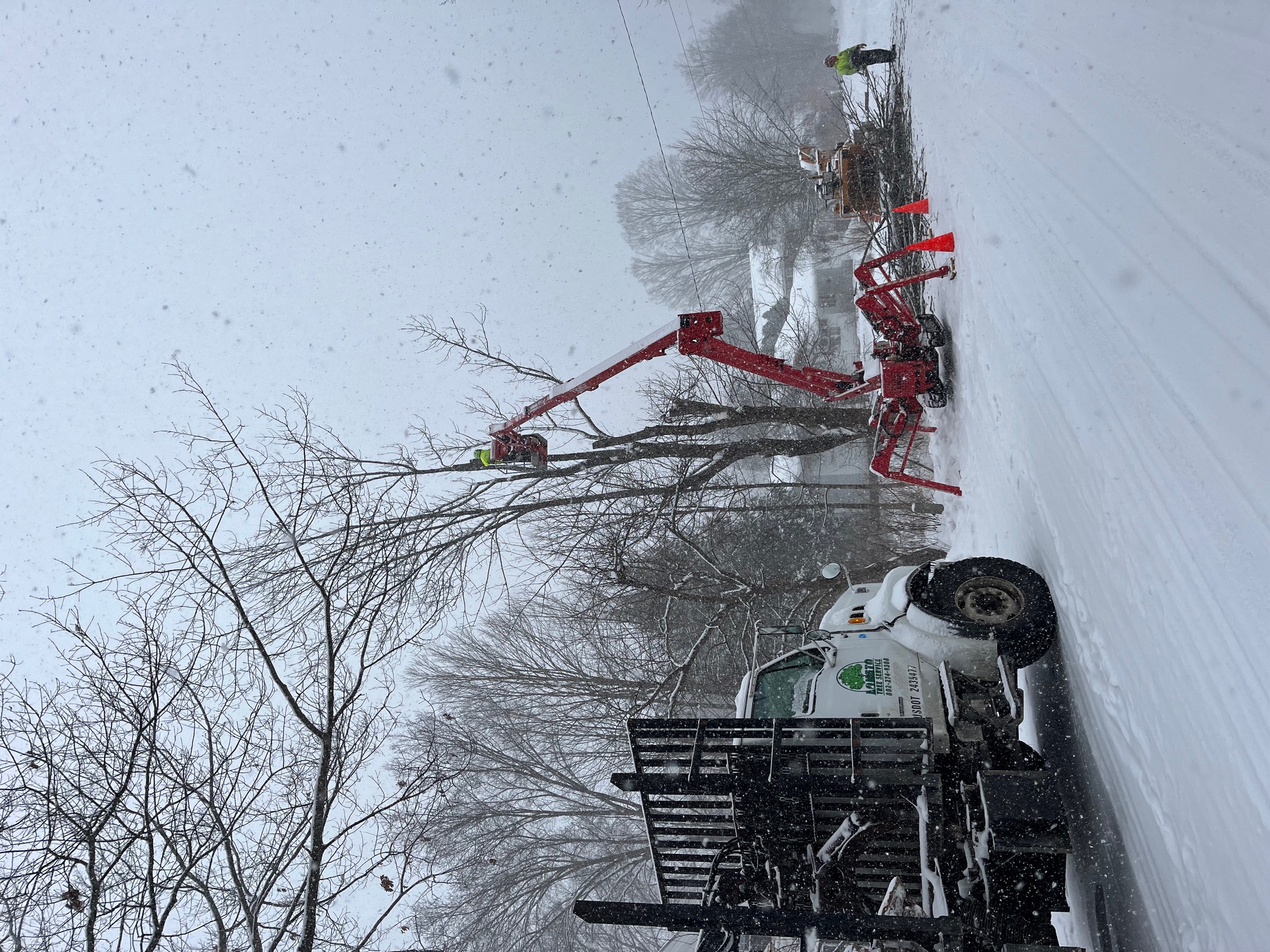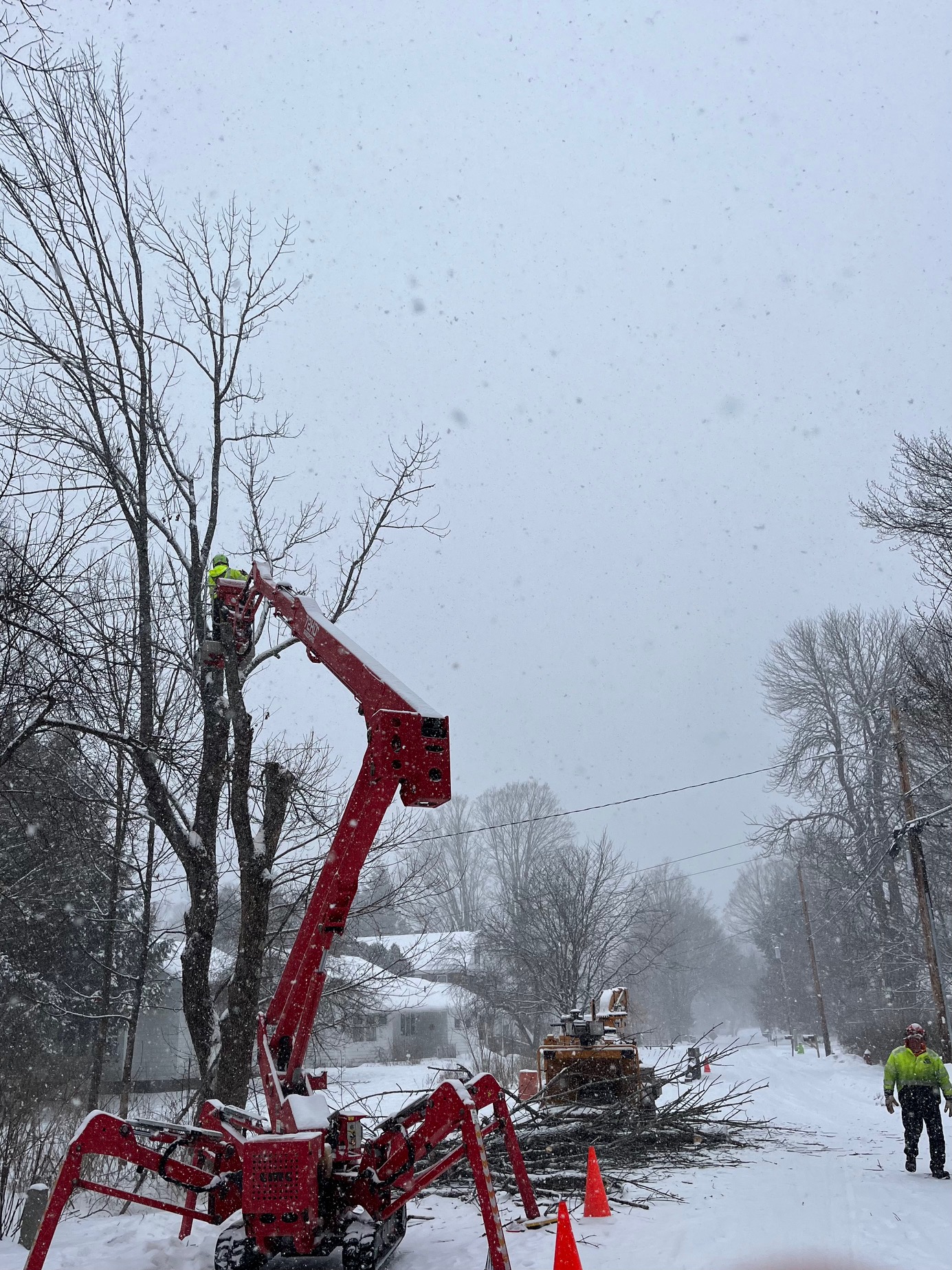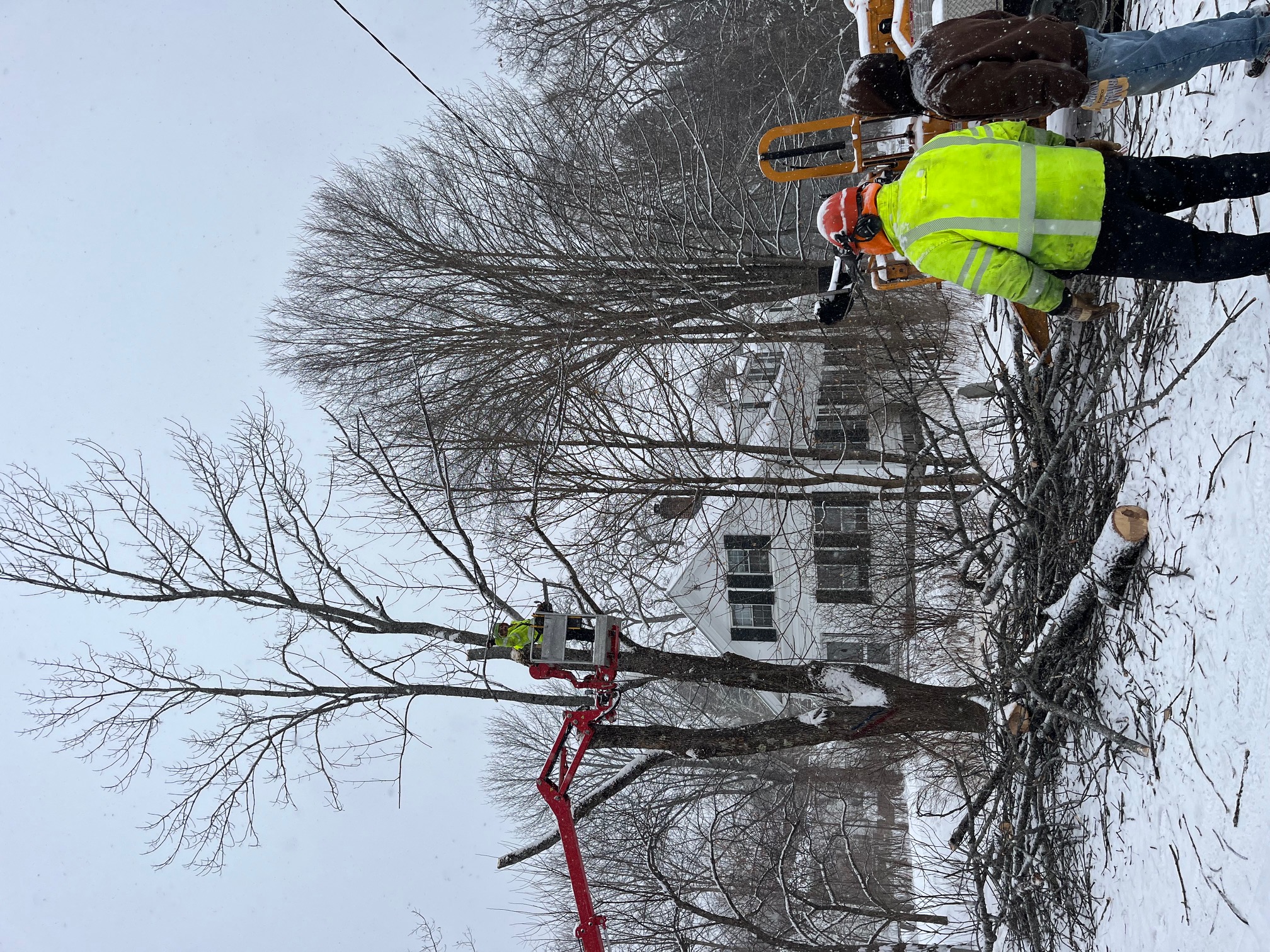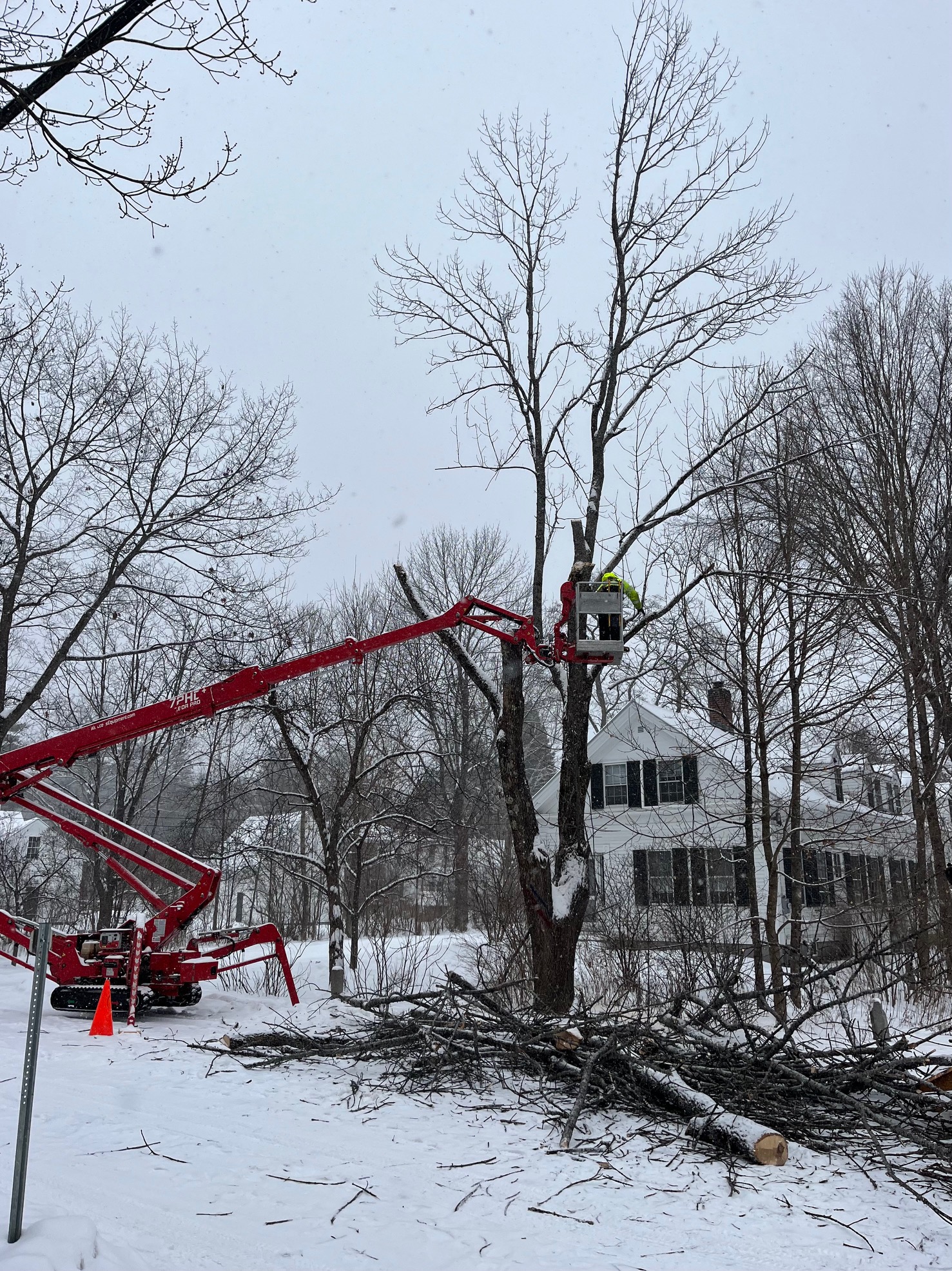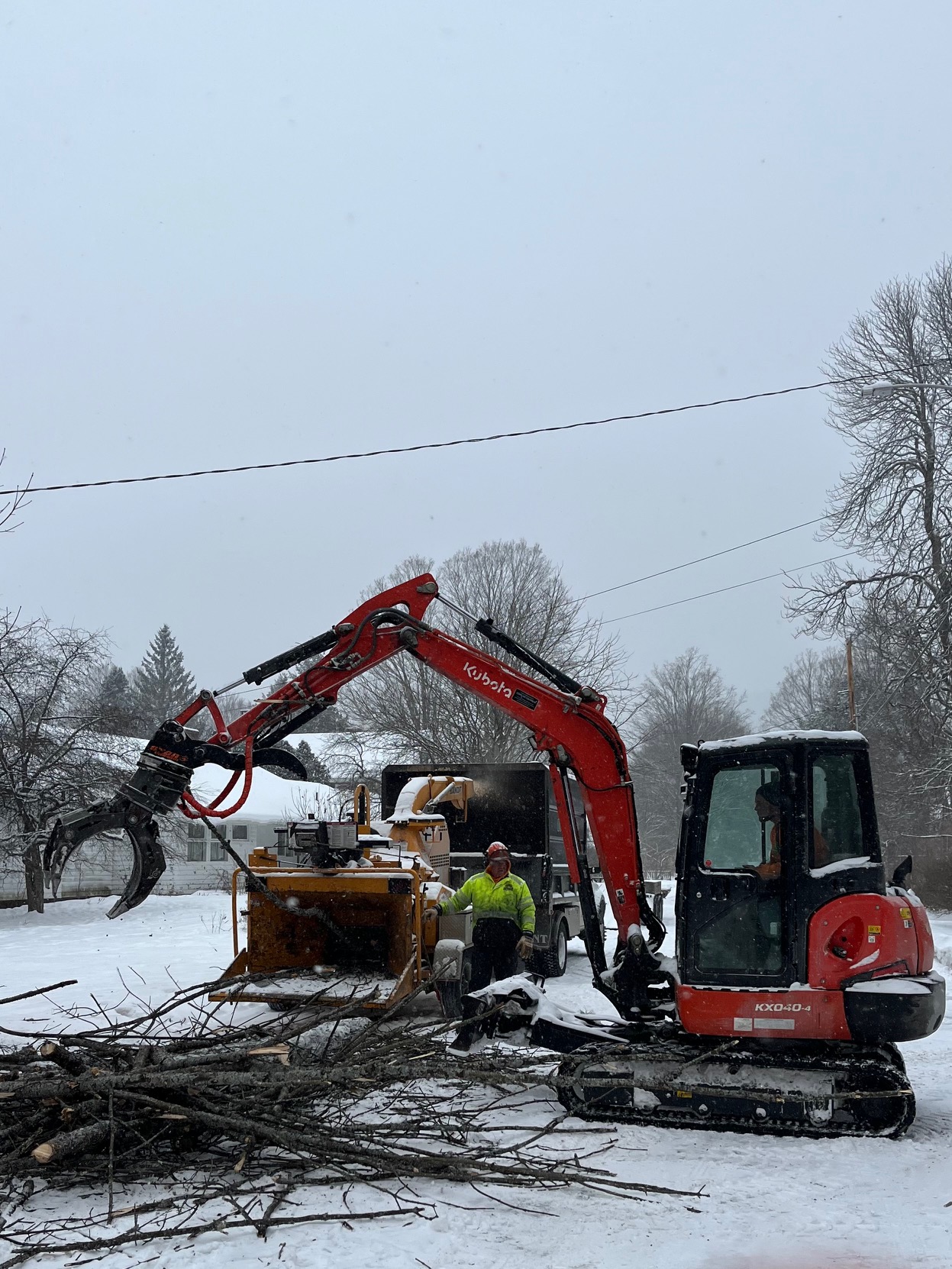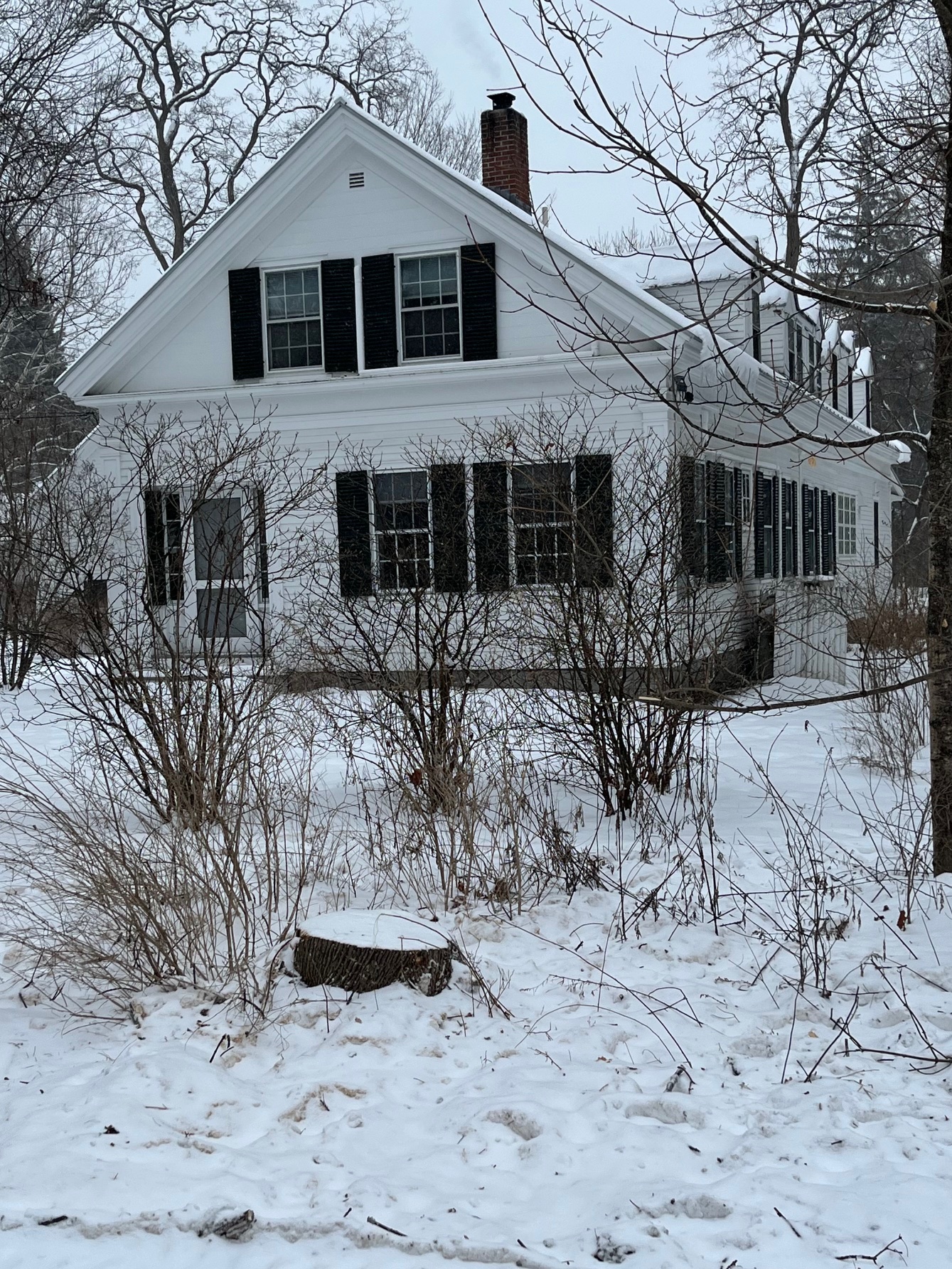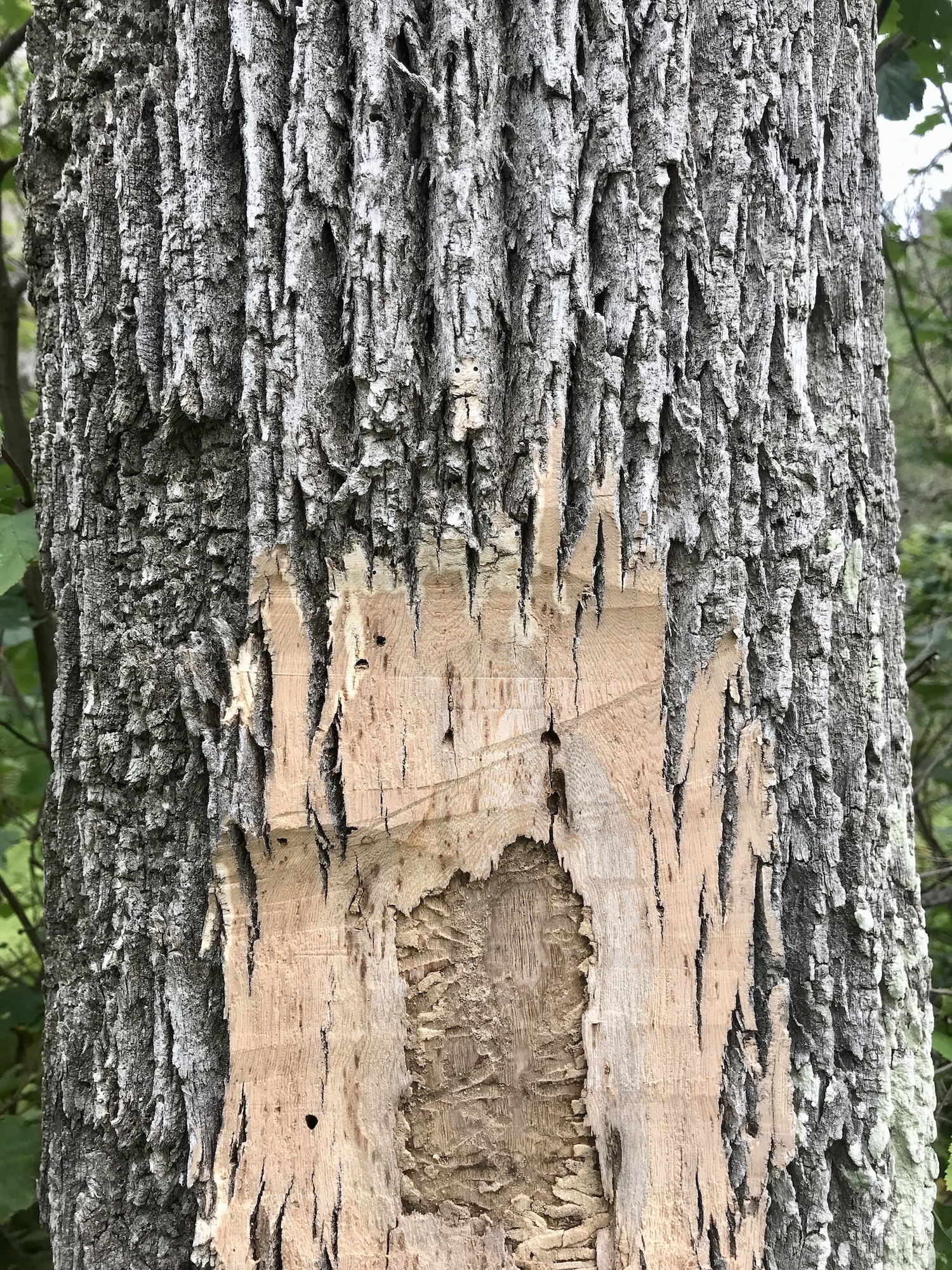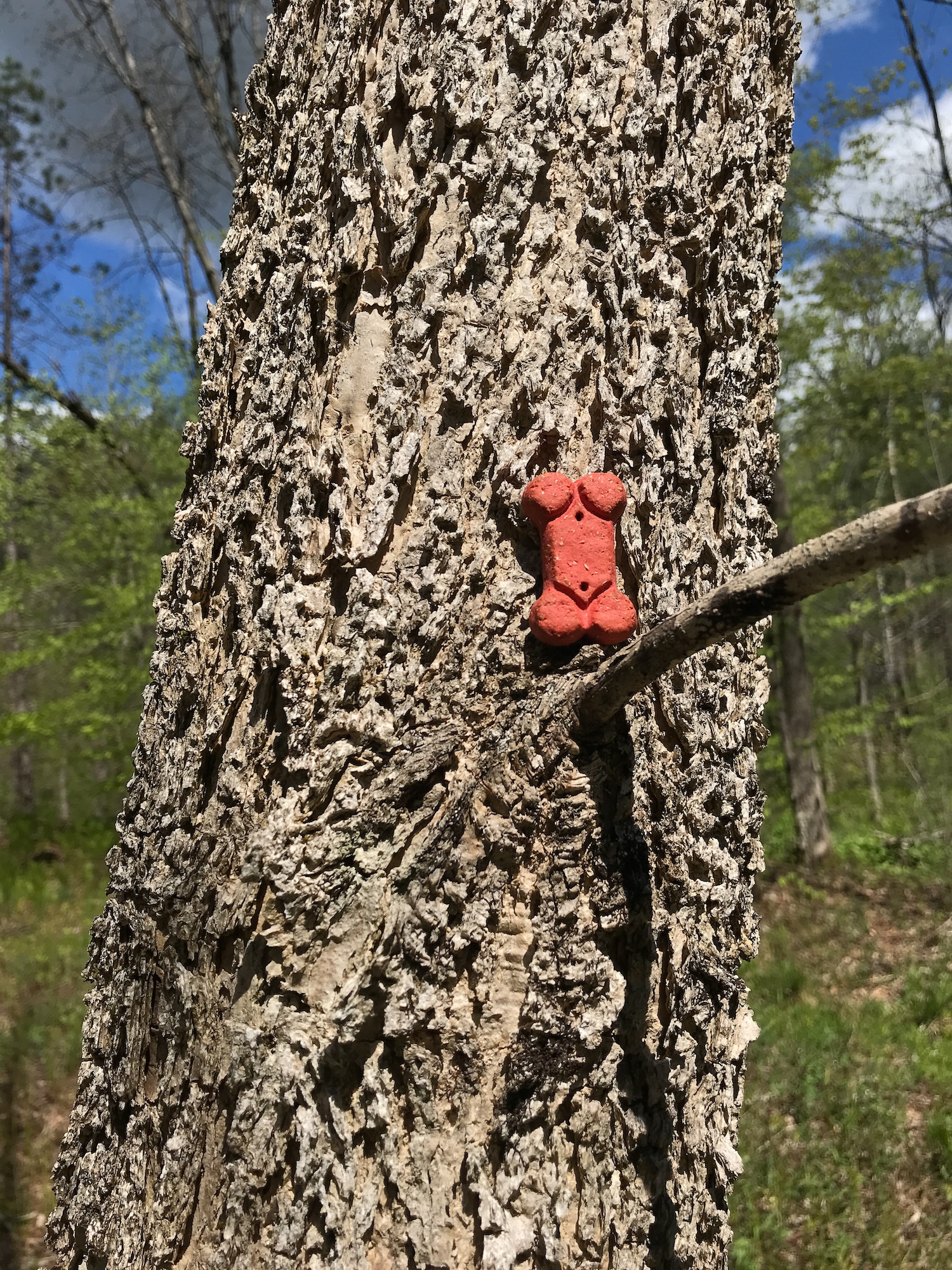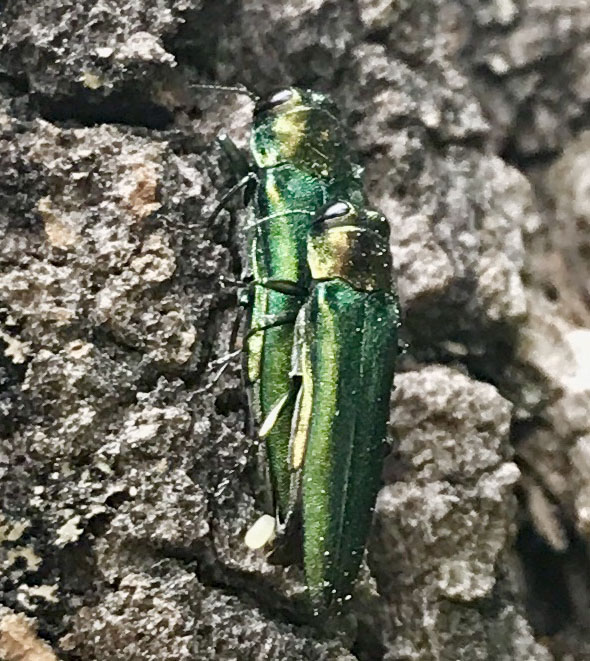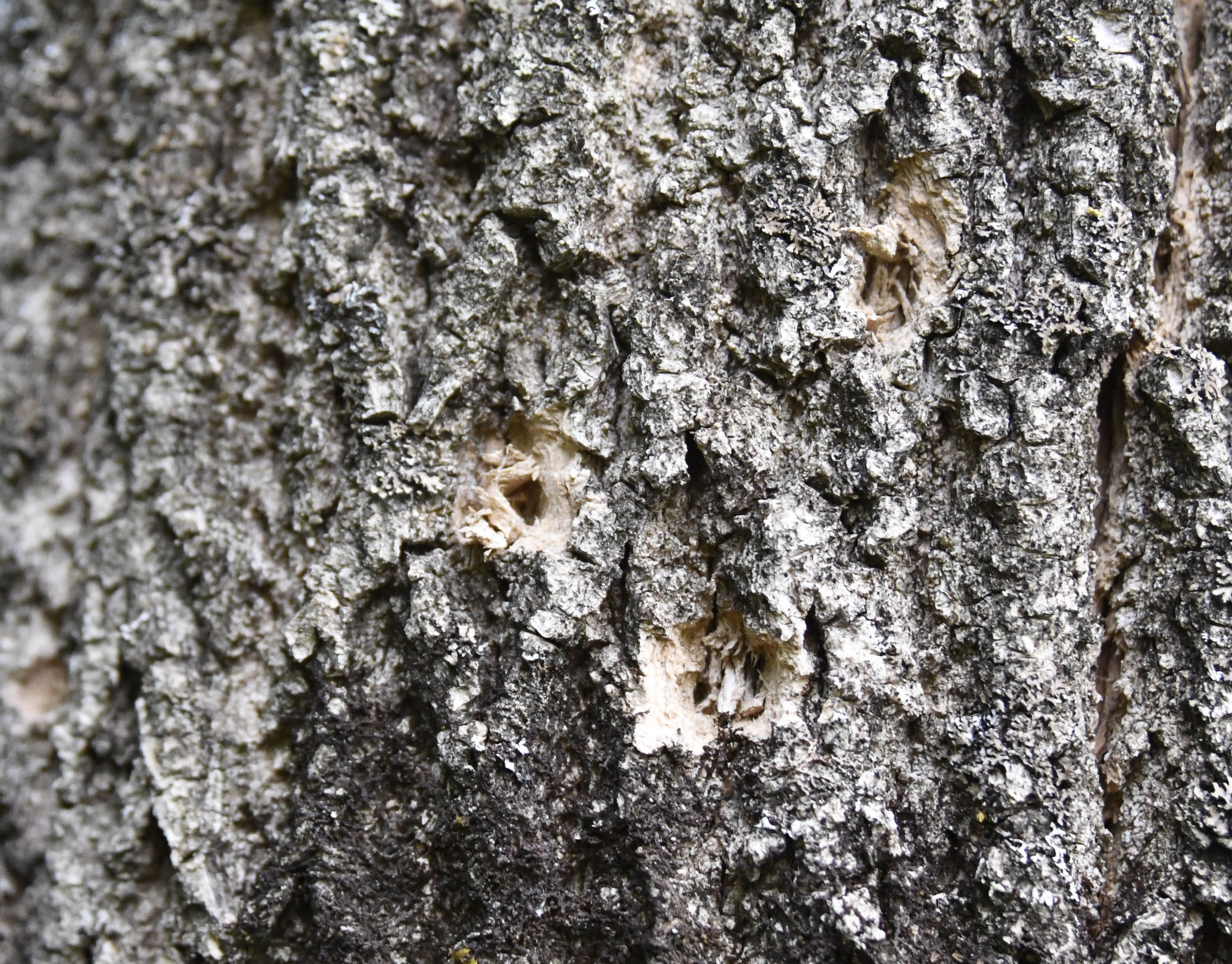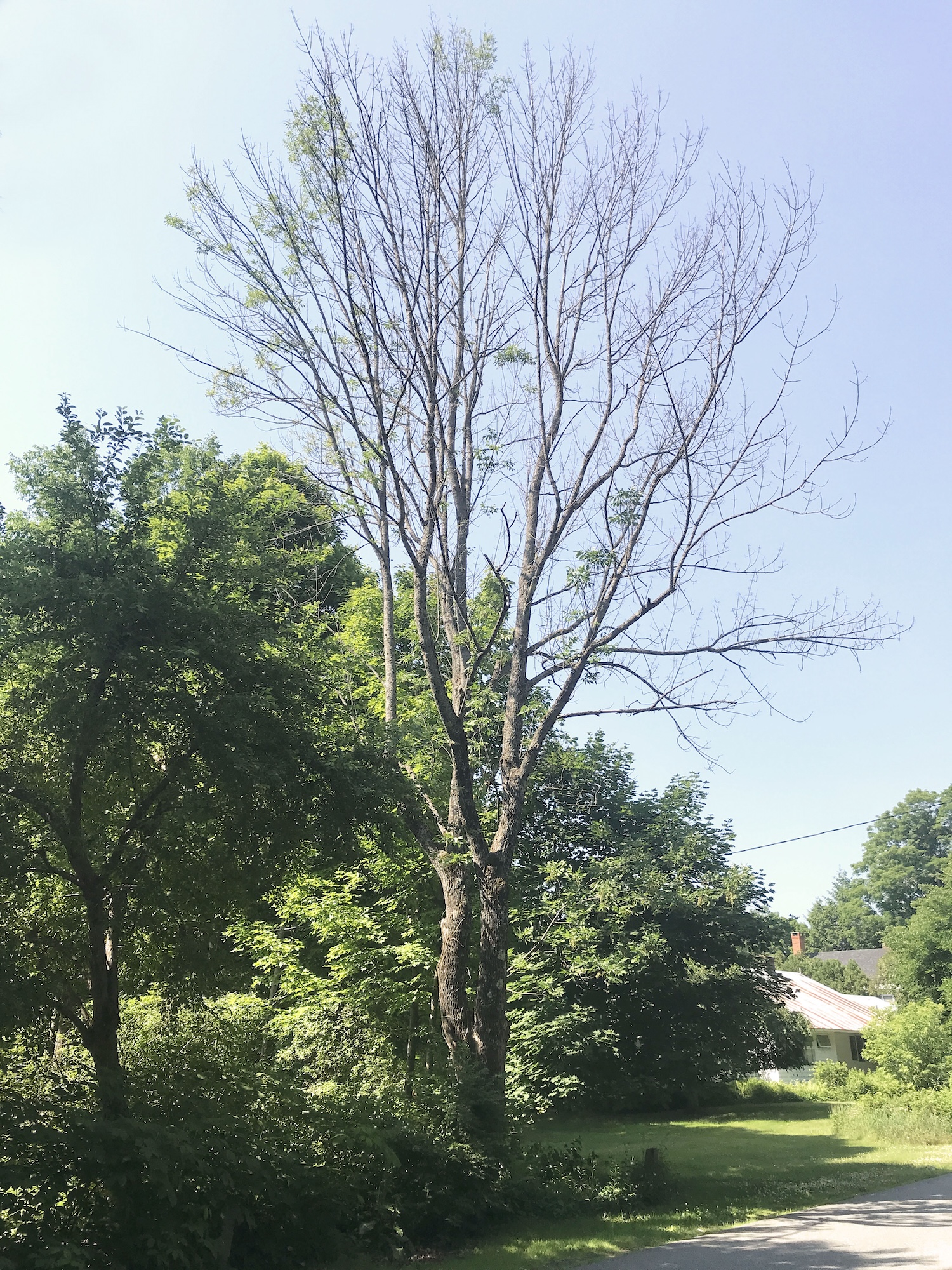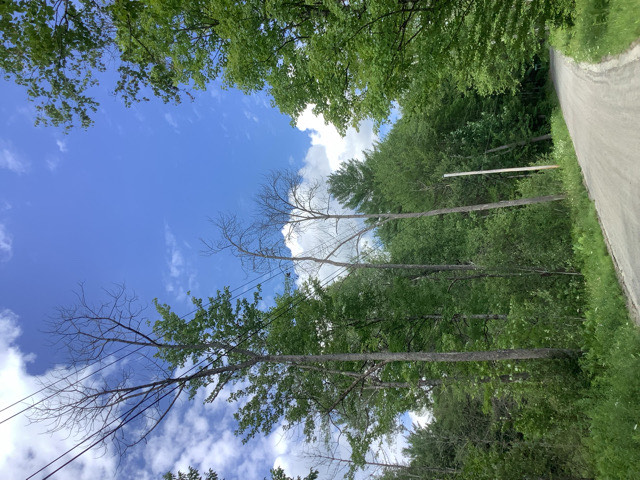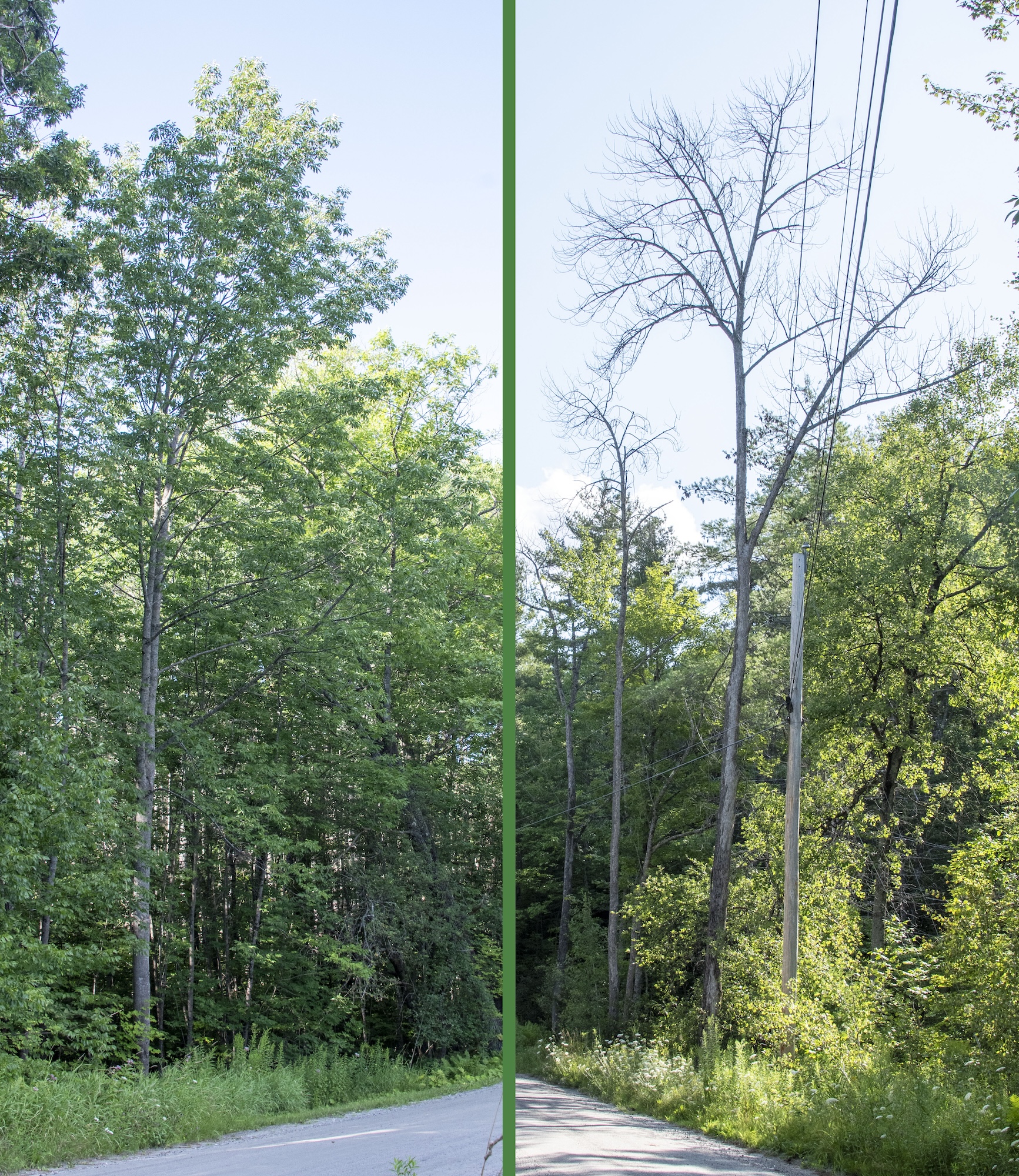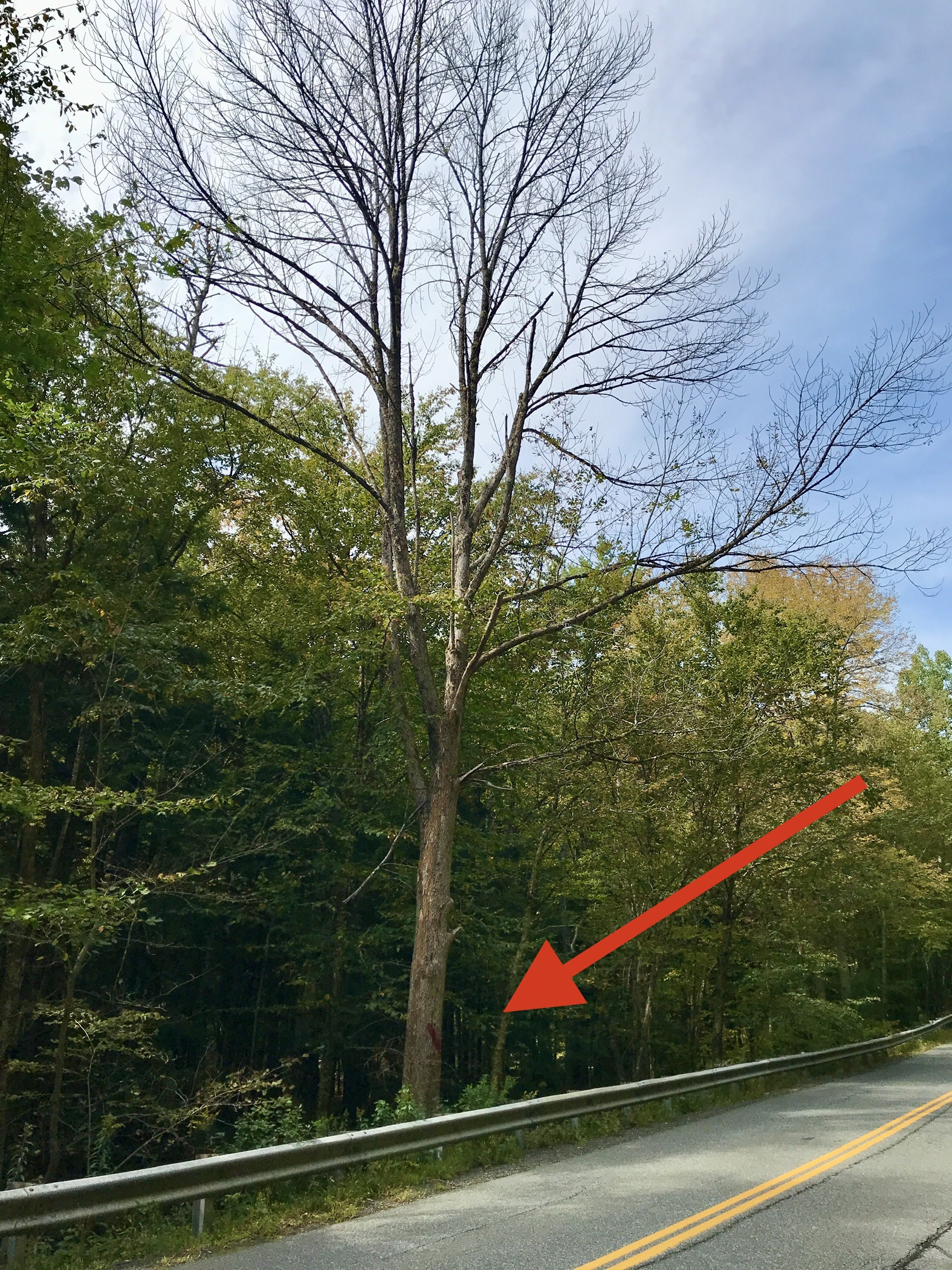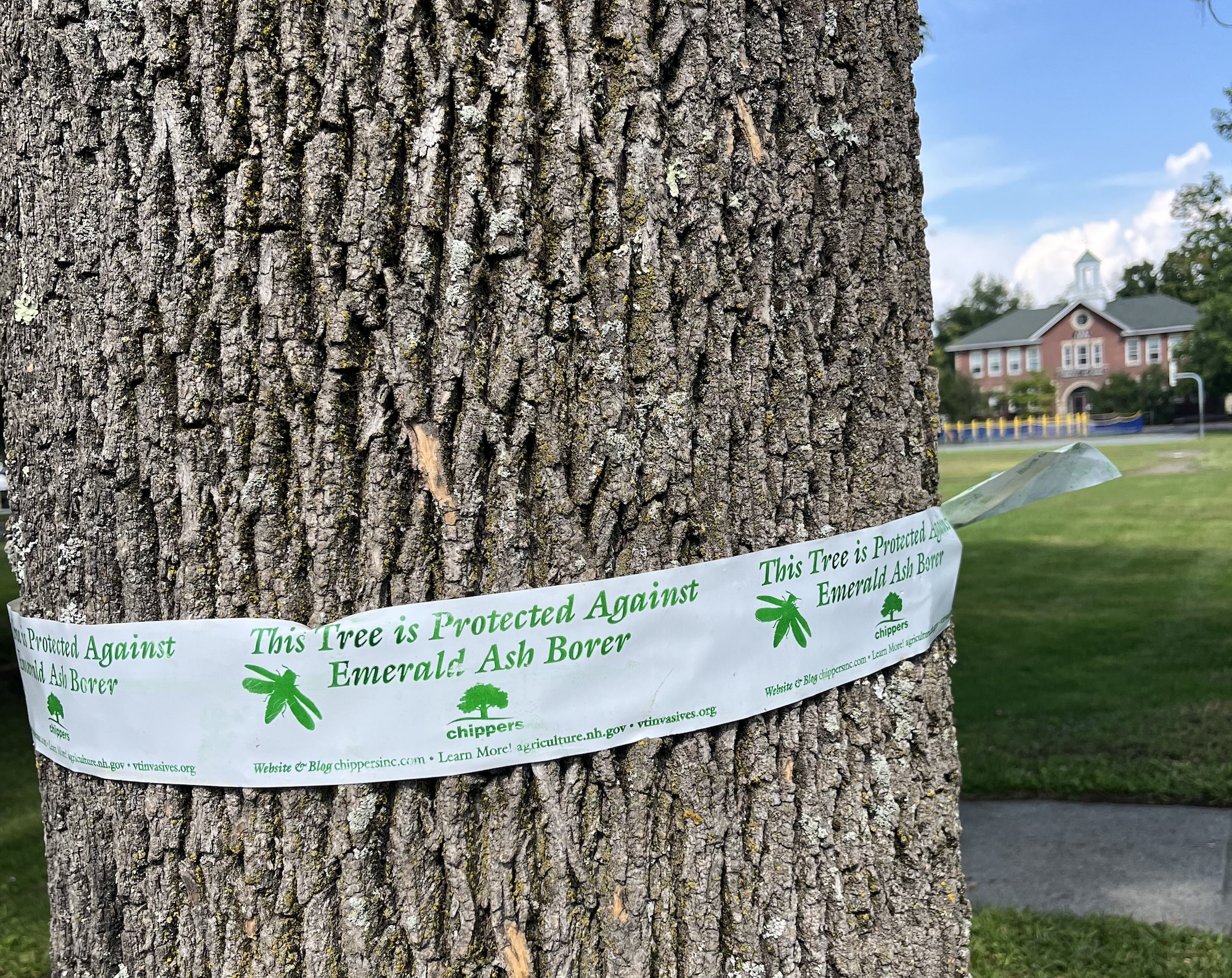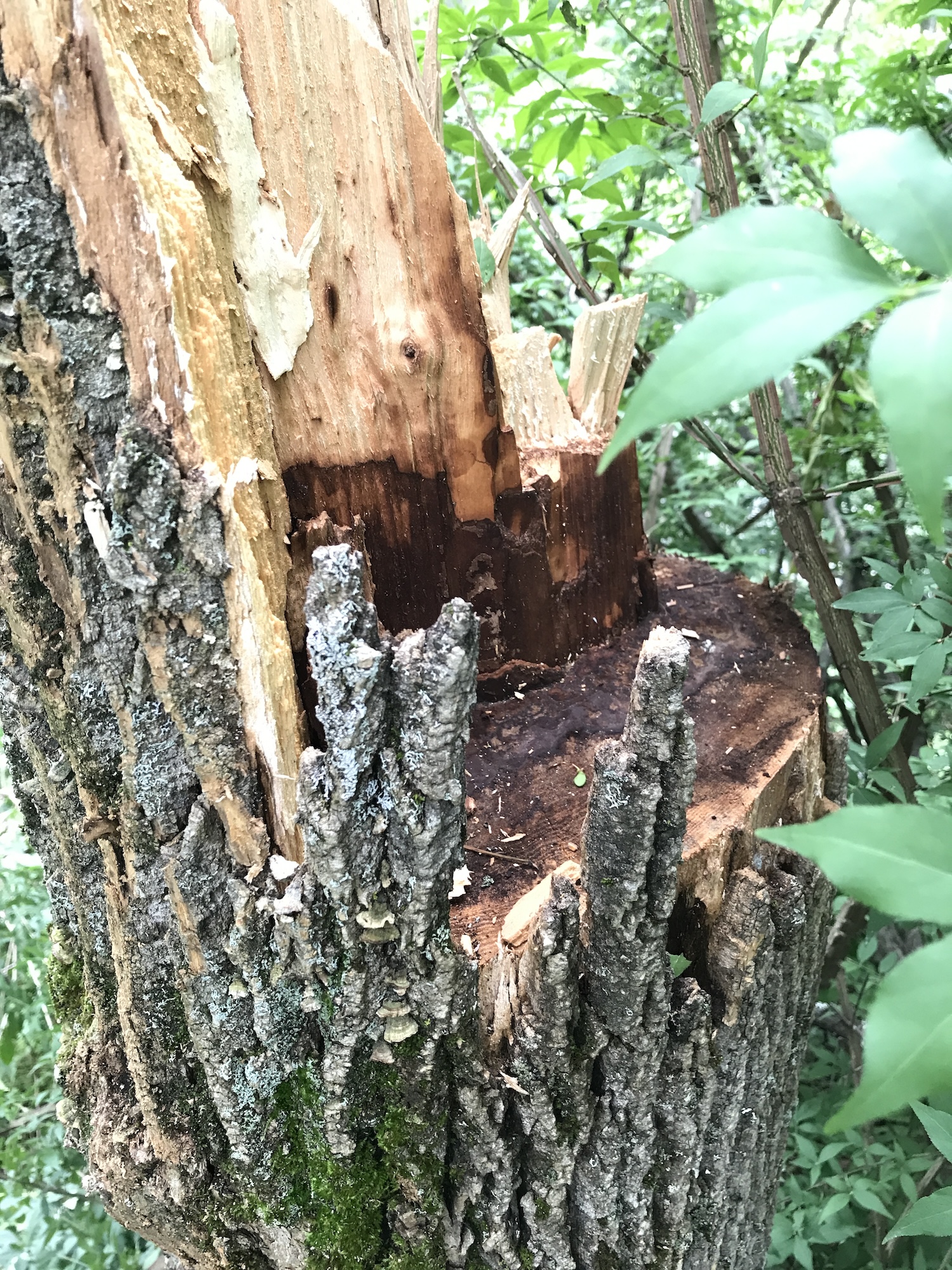Emerald Ash Borer
Emerald Ash Borer — a Destructive Insect Pest Demands Immediate Attention in Norwich
The winter 2024 discovery of emerald ash borer (EAB) in Norwich came as no surprise. Since the 2018 arrival of this non-native beetle in Vermont, where it was first documented in Orange County, it has rapidly spread and is currently known to be present in all of the state’s 14 counties outside the Northeast Kingdom (see map of known infected areas). EAB (Agrilus planipennis) was first found in the U.S. in southeastern Michigan in 2002. Native to Asia and eastern Russia, it is believed to have been introduced as early as the 1990s in solid wood packing material from Asia. Belonging to the beetle family Buprestidae, EAB feeds exclusively on ash trees in the genus Fraxinus. Vermont’s three species of ash — white, black, and green — make up 5-7% of all hardwood trees in the state, with much higher percentages in some areas. As of early 2024, this tiny green beetle has killed millions of ash trees in 36 states and 5 Canadian provinces, causing devastation not seen since Dutch Elm Disease and Chestnut Blight ravaged our streets and forests 50–100 years ago. This invasive insect will inevitably destroy most, if not all, ash trees in Norwich and beyond, posing significant human safety risks, threatening the ecological integrity of our forests, and diminishing a cherished cultural resource.
The ecology and impacts of EAB are well described in various online sources, including an informative fact sheet published by the Vermont Department of Forests, Parks, and Recreation, and a story map from the USDA Animal and Plant Health Inspection Service. Briefly, the half-inch long, bullet-shaped, metallic green adult beetles lay eggs in the crevices of ash bark, where the larvae tunnel into the cambium and feed on the phloem, which is the vascular tissue responsible for transporting nutrients throughout the plant. As larvae feed on this vascular tissue, the tree becomes less able to transport nutrients to the leaves in its canopy, killing the tree from the top down in a span of 2–5 years, depending on its size and health. Infested ash trees rapidly begin to dry out and lose their structural integrity; branch and trunk breakage in diseased ash trees is often sudden and unpredictable, posing a serious hazard to people and property. Infestation can expand naturally and rapidly at a rate of 1–2 miles per year. Learning to identify ash trees and the symptoms of EAB damage are vital first steps to understand and manage a local infestation.
The State of Vermont has taken EAB very seriously since it emerged on the radar of forest managers and ecologists over a decade ago. The Vermont Urban and Community Forestry program (VUCFP) has a dedicated web page on EAB Management, which highlights the many resources available to communities like Norwich that are striving to manage this damaging insect pest. Vermont Invasives offers a similarly excellent overview of EAB and its impacts, also providing numerous resources for Vermonters. A number of Vermont communities have adopted formal plans to prepare for and manage EAB infestations; these are available here. Although the Norwich Conservation Commission (NCC) conducted preliminary roadside counts of ash trees in 2018 and 2019, in anticipation of EAB’s arrival, our town does not yet have a management plan in place. The process of creating such a plan is now fully underway.
Three basic options exist for managing EAB infestations, and most Vermont communities have adopted action plans that combine all three. Briefly, these include:
- Stem inoculation of ash trees that are considered high-value, because of their cultural, aesthetic and/or historic importance to a community or an individual landowner. Treatment must be conducted while trees are fully leafed out, between June and mid-September. See our page on Emerald Ash Borer Resources for more specific information on inoculation options.
- Preemptive removal of healthy ash trees that, once infected, will pose an unacceptable risk to property, infrastructure and/or public safety.
- Allowing trees that are neither high-value nor a risk to public property and safety to become infected and die naturally. This latter strategy typically applies to ash trees that are situated away from public spaces, residential homes, or commercial buildings.
Inaction on managing EAB impacts is not an option for Norwich – or any community with ash trees. The documented presence of this destructive pest near our village center underscores the urgent need to develop and implement an effective action plan. Town officials, including the Tree Warden and members of NCC, are working hard to craft an immediate and effective management plan. That plan, when completed, will be adjusted and adapted in response to the progression of Norwich’s EAB infestation and new knowledge that emerges. Proactive treatment or removal will unquestionably be expensive, but reactive removal of infested ash trees and the damage they cause will entail significantly higher costs, thus the importance of developing and implementing a management plan.
EAB will affect every Norwich resident, as it proliferates and begins to kill our ash trees. We must all learn about this invasive insect, monitor our own properties for evidence of infestation, educate our neighbors, pay close attention to upcoming community initiatives for managing our ash trees and planting replacements, and be prepared to pitch in. Only a concerted, coordinated management plan and town-wide effort will avert the worst disruption and expense that EAB is poised to inflict on Norwich.
EAB Inoculation Matching Gift Opportunity
The Norwich Conservation Commission (NCC) needs your help to preserve ash trees in our town’s public spaces. Thanks to generous challenge grants offered by longtime Norwich residents Jane and Bill Stetson and Mary and Steve Gorman, our town has an outstanding opportunity to contribute towards inoculating healthy ash trees against infestation by emerald ash borer (EAB). Please consider contributing a gift to help match these two challenge grants and make these inoculations possible. A gift in any amount can be sent to the Vermont Center for Ecostudies (VCE), a 501(c)(3) nonprofit, which has offered to support our efforts as a means of enabling your tax-deductible gift. Checks can be mailed to VCE (P.O. Box 420, Norwich, VT 05055), with a note in the memo line Norwich EAB. Alternatively, donations can be made securely on VCE’s website, choosing “Other” as the gift designation and typing Norwich EAB in the dedication box.
The EAB infestation continues to weaken and kill ash trees throughout Norwich, as well as the entire Northeast. Although most trees will inevitably die − and many hundreds that line our roadways will need to be removed − Norwich residents have an excellent opportunity to save a number of prominent and still-healthy ash through inoculation. Emamectin benzoate is an approved and safe insecticide that targets EAB and keeps uninfested or lightly-infested trees from succumbing.
The NCC encourages Norwich residents to take advantage of the Stetsons’ and Gormans’ generous gesture to support inoculation of ash trees in our shared public spaces. Together, their two challenge grants amount to $3,000, which must be matched 1:1 by gifts from other townspeople. If we succeed in raising the full match, $6,000 will be available to ensure the health of ash trees in some of our town’s most frequented and beloved locations.
Again, a tax-deductible gift in any amount can be made to the Vermont Center for Ecostudies as described above. VCE has created a special account to hold and manage these funds, and the Norwich Selectboard unanimously approved this arrangement at its March 12, 2025 meeting.
On behalf of Jane and Bill Stetson, Mary and Steve Gorman, Town of Norwich officials, and VCE, we thank you all in advance for pitching in to help Norwich preserve some of our most valued ash trees in cherished public spaces! And, we are sincerely grateful to the many of you who have already made matching gifts.
Photos
Click to see a larger version, with caption.
